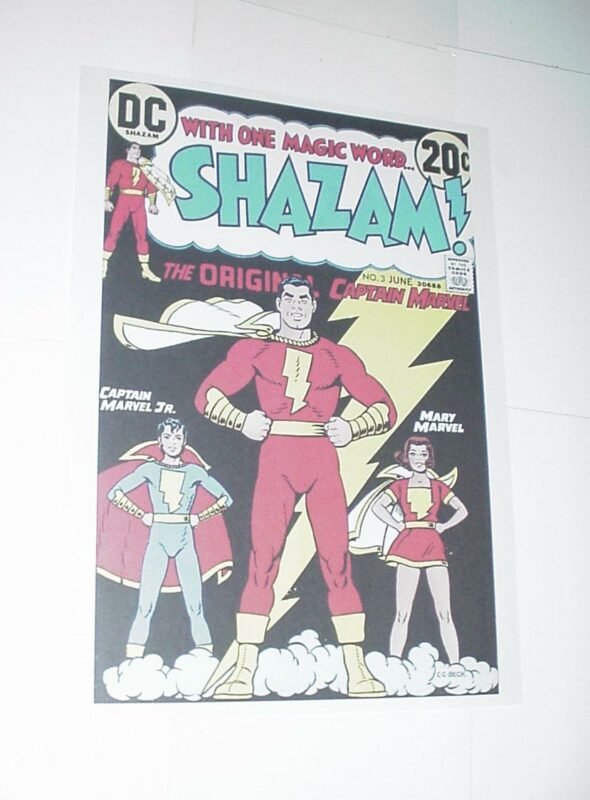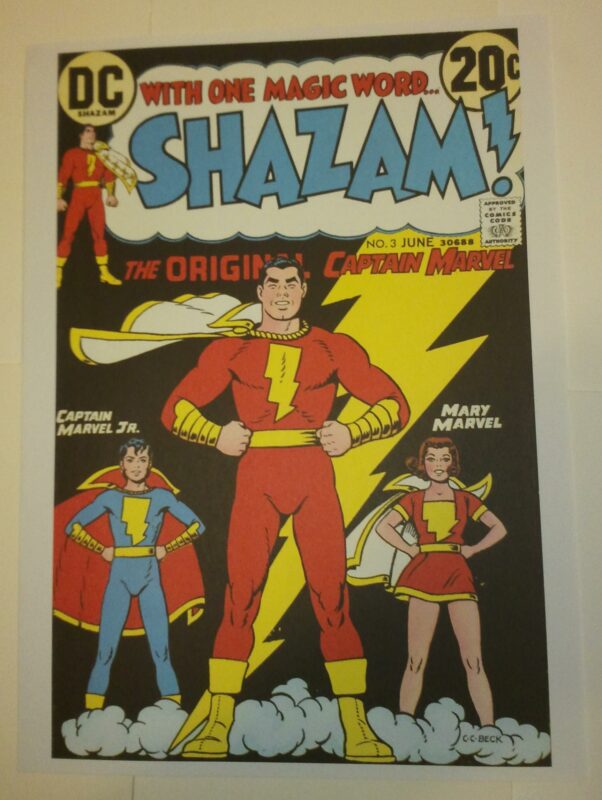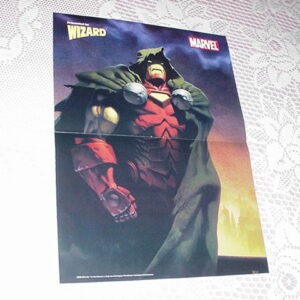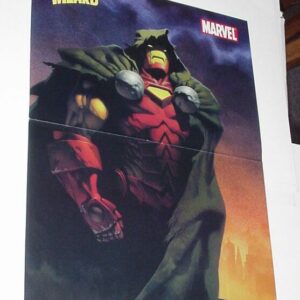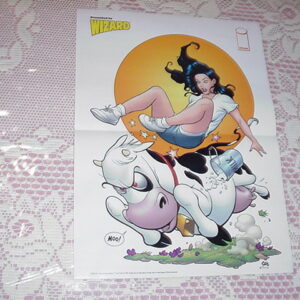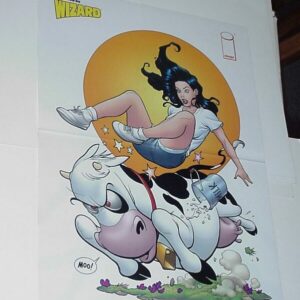Captain Marvel Poster #1 Mary and Jr. Shazam! #3 (1973) C. C. Beck
$49.99
Description
Once upon a time, Captain Marvel was more popular that Superman. But declining sales and the effects of a lawsuit by DC (whose executives felt the character infringed on its Superman copyright) drove the so-called “Big Red Cheese” to cancellation in 1953. After he languished in limbo for nearly twenty years, DC began planning a revival. Original Captain Marvel artist C.C. Beck was even brough back to push the pencil once more, and while the book- now retitled Shazam! to address the legal concerns of Marvel Comics- retained some of the whimsical flavor of the old series, it failed to strike lightning with readers. A disgruntled Beck walked off the job after ten issues, reportedly over creative conflicts with editor Julius Schwartz. Always more popular with children than young adults, Shazam! fared better as a Saturday morning TV show later in the decade. “As an illustrator I could, in the old days, make a good story better by bringing it to life with drawings. But I couldn’t bring the new [Captain Marvel] stories to life no matter how hard I tried.”-C.C. Beck. Captain Marvel, also known as Shazam, is a fictional superhero originally published by Fawcett Comics and later by DC Comics. Created in 1939 by artist C. C. Beck and writer Bill Parker, he first appeared in Whiz Comics #2 (February 1940) with a premise that taps adolescent fantasy. Shazam is the alter ego of Billy Batson who works as a radio news reporter and was chosen to be a champion of good by an ancient wizard (also named Shazam). Whenever Billy speaks the word “Shazam!”, he is struck by a magic lightning bolt that transforms him into an adult superhero empowered with the abilities of six archetypal, historical figures. Several friends and family members, most notably Marvel Family/Shazam Family cohorts Mary Marvel and Captain Marvel Jr. can share Billy’s power and become “Marvels” themselves. Hailed as “The World’s Mightiest Mortal” in his adventures, Captain Marvel/Shazam was nicknamed “The Big Red Cheese” by arch-villain Doctor Sivana, an epithet later adopted by Captain Marvel’s fans. Based on sales, Captain Marvel was the most popular superhero of the 1940s, as his Captain Marvel Adventures comic book series sold more copies than Superman and other competing books of the time. Captain Marvel was also the first comic book superhero to be adapted to film, in a 1941 Republic Pictures serial titled Adventures of Captain Marvel. Fawcett ceased publishing Captain Marvel-related comics in 1953, partly because of a copyright infringement suit from DC Comics alleging that Captain Marvel was a copy of Superman. In 1972, DC licensed the Marvel Family characters and returned them to publication, acquiring all rights to the characters by 1991. DC has since integrated Captain Marvel and the Marvel Family into their DC Universe, and have attempted to revive the property several times with mixed success. Because Marvel Comics trademarked their Captain Marvel comic book during the interim between the original Captain Marvel’s Fawcett years and DC years, DC has used the trademark Shazam! to promote the property since 1972, instead of the name “Captain Marvel”. Consequently, Captain Marvel himself has often been referred to as “Shazam”, leading to DC to rename the character as such during their New 52 relaunch in 2012. Captain Marvel was ranked as the 55th greatest comic book character of all time by Wizard magazine. IGN also ranked Captain Marvel as the 50th greatest comic book hero of all time, stating that Captain Marvel will always be an enduring reminder of a simpler time. UGO Networks also placed him as one of the top heroes of entertainment, quoting, “At his best, Shazam has always been Superman with a sense of crazy, goofy fun”. When superhero comics became popular again in the mid-1960s in what is now called the Silver Age of Comic Books, Fawcett was unable to revive Captain Marvel, having agreed never to publish the character again in order to settle the lawsuit. Carmine Infantino, publisher of DC Comics, licensed the characters from Fawcett in 1972, and DC began planning a revival. Because Marvel Comics had by this time established Captain Marvel as a comic book trademark, DC published their book under the name Shazam! Since then, that title has become so linked to Captain Marvel that many people have taken to identifying the character as “Shazam” instead of his actual name. The Shazam! comic series began with Shazam #1, dated February 1973. It contained both new stories and reprints from the 1940s and 1950s. The first story attempted to explain the Marvel Family’s absence by stating that they, Dr. Sivana, Sivana’s children, and most of the supporting cast had been accidentally trapped in suspended animation for twenty years when the Sivanas attempted to put the Marvels into suspended animation, until finally breaking free when the Suspendium globe moved towards the Sun. Dennis O’Neil was the primary writer of the book; his role was later taken over by writers Elliot S. Maggin and E. Nelson Bridwell. C. C. Beck drew stories for the first ten issues of the book before quitting because of creative differences; Bob Oksner and Fawcett alumnus Kurt Schaffenberger were among the later artists of the title. With DC’s Multiverse concept in effect during this time, it was stated that the revived Marvel Family and related characters lived within the DC Universe on the parallel world of “Earth-S”. While the series began with a great deal of fanfare, the book had a lackluster reception. The creators themselves had misgivings; Beck said, “As an illustrator I could, in the old days, make a good story better by bringing it to life with drawings. But I couldn’t bring the new [Captain Marvel] stories to life no matter how hard I tried.” Mark Marvel is the twin sister of Earth’s mightiest mortal, the heroic Captain Marvel. By uttering the name of the wizard Shazam, Mary is granted the power of the greatest Olympian Gods and the Biblical Solomon becoming Mary Marvel. While on a fishing trip with his grandfather, Freddy Freeman got his first taste of tragedy. Captain Nazi came into the area in mid fight with the superhero Captain Marvel and Mary Marvel, his sister and sidekick. Captain Nazi notices the two and did the unthinkable: he killed Freddy’s grandfather in a single shot. He also crippled Freddy with this attack. When the Super Duo realized this accident, they rushed to the wizard known as Shazam. They pleaded with him to restore Freddy’s body back to him in full. The Wizard suggested they share there power with him. Captain Marvel did just that by giving a portion of his power to Freddy, creating Captain Marvel Jr. Charles Clarence Beck (June 8, 1910 – November 22, 1989) was an American cartoonist and comic book artist, best known for his work on Captain Marvel at Fawcett Comics and DC Comics. He was inducted into the comic book industry’s Will Eisner Comic Book Hall of Fame in 1993 and the Jack Kirby Hall of Fame in 1997. His first return to comics was in the mid-1960s for the short-lived Milson Publications who published three issues of his creation Fatman the Human Flying Saucer. This character was almost the inverse of Captain Marvel in appearance and coloration, but with very different powers. Then in 1973 he was the initial artist for DC Comics’ revival of Captain Marvel, titled Shazam! due to trademark issues. Beck left after the tenth issue due to “creative differences” regarding plotlines. Subsequently at the invitation of E. Nelson Bridwell, Beck submitted a script for a new story “Captain Marvel Battles Evil Incarnate.” After Bridwell returned it with extensive editorial changes Beck attempted to draw the rewritten version but became so dissatisfied with it that he tore up the artwork he had drawn thus far and returned the Bridwell draft to DC.
